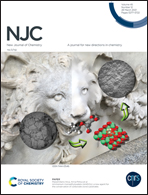Influence of hollow sphere surface heterogeneity and geometry of N-doped carbon on sensitive monitoring of acetaminophen in human fluids and pharmaceutical products†
Abstract
The construction of electrochemical sensors/biosensor electrodes with high signaling transduction, amplification, and facile molecular transport of biomolecules is a great challenge in pharmaceutical formulations and biological applications. Here, we investigate the leverage of spherical surface features in terms of morphology, well-distributed active-sites, heterogeneity, and space vacancies on the sensitive monitoring of acetaminophen (AC) in human fluids and pharmaceutical products. A variety of spherical morphologies with nitrogen-doped carbon matrices were designed along the electrode surfaces. For instance, we fabricated three-sphere structures and surface morphologies based on carbon microspheres (CMS), N-doped carbon spheres with large, micrometric sized holes (N-CSB), and N-doped hollow conjugated carbon spheres with a number of holes and bowls on top of the spherule surfaces (N-HCCS), respectively. The catalytic activity and sensing properties of CMS-, N-CSB-, and N-HCCS-modified electrodes for the selective screening of AC were examined. The intrinsic N-HCCS electrodes showed high signaling transduction and amplification, fast response, low surface electron/charge resistance, facile molecular transport, mobility, and AC target diffusion among all electrode surfaces. The N-HCCS-based sensor shows a limit of detection (LOD) of 0.08 ± 0.002 μM and a wide linear range of 10–800 μM (S/N = 3). The N-HCCS electrochemical sensor was also designed for an AC monitoring assay in various real sample sources, such as human serum and urine, with a high recovery rate of 99.93%. The functions of the intrinsic N-HCCS electrode enabled the selective and sensitive determination of a wide range of AC in pharmaceutical products with high stability and good reproducibility. Our finding provides evidence that the designed N-HCCS can be employed in clinical applications and quality control measurements.



 Please wait while we load your content...
Please wait while we load your content...